Identify the Skulls: Answers Update
Posted by: Loren Coleman on June 7th, 2012
The identification of skulls is a good skill to acquire in working in the field of hominology, a subdivision of cryptozoology. I’m no expert, and I’m sure many of my readers have fine-tuned this skill more than I have. With that in mind, today, let’s play a little id game with a group of skulls.
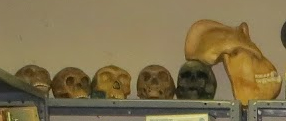
Michael Swords is the archivist in charge of housing the late Ivan T. Sanderson’s Society for the Investigation of the Unexplained (SITU) collection for the Society For Scientific Exploration, who acquired it. He has done a remarkable job organizing the old SITU files, and is to be congratulated for his labor in this realm.
In a recent entry on the status of the assemblage, Swords wrote of various items in his sort. (I’ll have some more to say about that later, including that troubling Shipton business again. See “A Short History of the Shipton Snowman Track Photographs and the Tchernezky Cast,” and “Shipton Yeti Created Cast: Keel’s Misstatement.”) But when discussing the new shelving he’s been working on for the collection, Swords notes that
Sharp-eyed observers might have noticed a Gigantopithecus skull [reconstruction by Grover Krantz] and five pre-modern Homo-whatevers on the top of the shelving in the rear. They weren’t part of the collection, but I’m donating them to it. Better with SITU than my own stuff.

I thought it would be fun and a good challenge to try to id these. I took a segment of his photo of the room, and enlarged the row of skulls from that image. If Swords knows the proper answers, he can grade me and any comment makers below.
So, lets go from left to right.
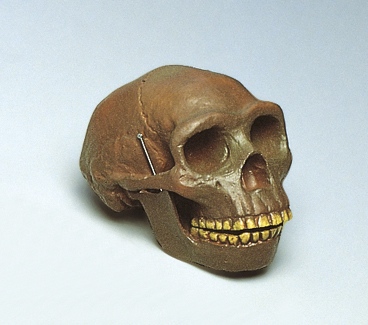
This first skull is behind part of a shelf, so I’m not sure, but I’d have to guess this might be a skull replica of the “Peking man,” Homo erectus pekinensis (Pithecanthropus pekinensis).
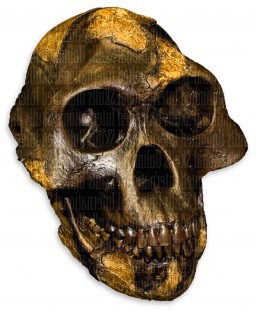
Or what is shown could be a skull replica of an Australopithecus, like Lucy. Need a better image.

The second skull copy in from the left is difficult to id, as well. It might be a Homo erectus (Java Man or Peking Man), or more probable, an archaic Homo sapiens, as is the example above. Need a better photo.
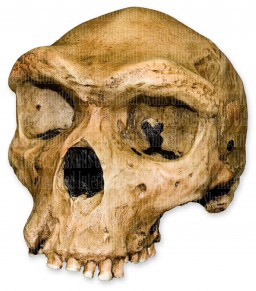
The third skull copy in from the left is definitely Broken Hill 1 (today called the Kabwe skull), the Rhodesian man (Homo rhodesiensis), which some paleoanthropologist have classified today as Homo neaderthalensis or Homo heidelbergensis. It was found in Broken Hill, Northern Rhodesia (now Kabwe, Zambia) in 1921 by Tom Zwiglaar, a Swiss miner. The brow ridges, plus eye and nose cavity shapes give this away, but it is the notch on the right side of the skull’s dental area that makes this a positive id.
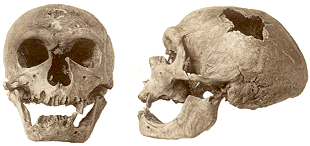
The skull fourth from the left is La Chapelle-aux-Saints 1 (also known as ‘The Old Man’). It is a skull model of the species Homo neanderthalensis. It was discovered in La Chapelle-aux-Saints, France by A. and J. Bouyssonie, and L. Bardon in 1908.

The fifth from the left, the darkest skull, is a replica of the original “Old man of Crô-Magnon,” today located in the Musée de l’Homme, Paris. The initial Cro-Magnon find was discovered in a rock shelter at Les Eyzies, Dordogne, France. The type specimen from the site is Cro-Magnon 1. The French geologist Louis Lartet discovered the first five skeletons of this type in March 1868 in a rock shelter named Abri de Crô-Magnon. Homo sapiens sapiens.
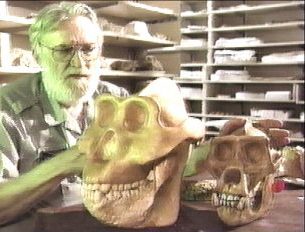
The last skull model, on the right in the row in the photo from Swords above, of course, is the reconstruction of Gigantopithecus, as Michael Swords mentioned. Here Grover is shown with his Giganto model on the left, compared to a gorilla skull on the right.
And what are your guesses on #1 and #2?
++++
How did you do?
Michael Swords id’ed the skulls later in the day, in reply to the above:
Loren has taken the opportunity to have a little detective enjoyment by figuring out the skulls on the top shelf of the one picture. The big one, as mentioned, is Grover Krantz’ reconstruction of Gigantopithecus. The others were plastic-like models purchased a very long time ago from Carolina Biological Supply Company [which I used in science lectures at WMU]. They turned out to be great size comparisons for Grover’s Bigfoot candidate.
Here are the skull identifications via Carolina:
1]. next to Gigantopithecus: Homo sapiens sapiens [ourselves], “Cro-Magnon Man” skull reproduction from the Vezere Valley in France.
2]. second from G’s left: Homo sapiens neanderthalensis, “Neanderthal Man”, from La Chapelle-aux-Saints, France.
3]. third from G’s left: Homo sapiens rhodesiensis, “Rhodesian Man”, from Broken Hill, northern Rhodesia.
4]. fourth from G’s left: Homo sapiens steinheimensis, “Steinheim Man”, from Steinheim near Stuttgart, Germany. Sort of a Cro-magnon/ Neanderthal “compromise.”
5]. last from G: Homo erectus pekinensis, “Peking Man”, from Choukoutien, China.
About Loren Coleman
Loren Coleman is one of the world’s leading cryptozoologists, some say “the” leading living cryptozoologist. Certainly, he is acknowledged as the current living American researcher and writer who has most popularized cryptozoology in the late 20th and early 21st centuries.
Starting his fieldwork and investigations in 1960, after traveling and trekking extensively in pursuit of cryptozoological mysteries, Coleman began writing to share his experiences in 1969. An honorary member of Ivan T. Sanderson’s Society for the Investigation of the Unexplained in the 1970s, Coleman has been bestowed with similar honorary memberships of the North Idaho College Cryptozoology Club in 1983, and in subsequent years, that of the British Columbia Scientific Cryptozoology Club, CryptoSafari International, and other international organizations. He was also a Life Member and Benefactor of the International Society of Cryptozoology (now-defunct).
Loren Coleman’s daily blog, as a member of the Cryptomundo Team, served as an ongoing avenue of communication for the ever-growing body of cryptozoo news from 2005 through 2013. He returned as an infrequent contributor beginning Halloween week of 2015.
Coleman is the founder in 2003, and current director of the International Cryptozoology Museum in Portland, Maine.










Number 1 is a Homo erectus (which includes Java man, Peking Man, etc). Sometimes African Homo erectus is labeled Homo egaster instead, and therefore this could also be a Homo egaster. It seems smallish, perhaps a child’s skull. I don’t think its a mold of the Turkana Boy (subadult Homo egaster, a near complete skeleton), but I could be wrong. I’m not ruling out a Homo habilis, but my best guess is erectus/egaster.
Number 2 looks like a Neanderthal skull. I can’t be sure whether it is Neanderthal or Archaic Homo sapiens, but some prehistoric humans grouped at times into Archaic Homo sapiens (like the Heidelbergs/Homo heidelbergensis, such as Rhodesian Man) had more primitive looking skulls than Neanderthals. Not positive, but I’d say i’m 60-75% sure its Neanderthal.
Considering that evidence of prehistoric European migrations to North America were basically dismissed for fifty years, I wonder what anomalous human remains may be lurking in the slag files of anthropology departs across the country. I mean if you’re going to disregard pottery and arrow heads, what would you do with the femur of Bigfoot? I know complete supposition, but still interesting.
Cool post, Loren, thanks. Your guesses seem pretty close to the mark, in my opinion. Like you, I defer to those who may have an expertise I don’t pretend to have.